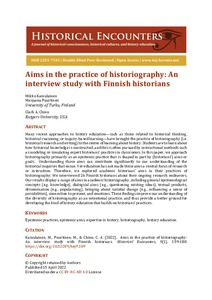Aims in the practice of historiography: An interview study with Finnish historians
Kainulainen Mikko; Puurtinen Marjaana; Chinn Clark A.
https://urn.fi/URN:NBN:fi-fe2022081154568
Tiivistelmä
Many recent approaches to history education—such as ones related to historical thinking, historical reasoning, or inquiry-based learning—have brought the practice of historiography (i.e. historical research and writing) to the center the learning about history. Students are to learn about how historical knowledge is constructed, and this is often pursued by instructional methods such as modeling or simulating expert historians’ practices in classrooms. In this paper, we approach historiography primarily as an epistemic practice that shaped in part by (historians’) aims or goals. Understanding those aims can contribute significantly to our understanding of the historical inquiries that ensue. Yet education has not made these aims a central focus of research or instruction. Therefore, we explored academic historians’ aims in their practices of historiography. We interviewed 26 Finnish historians about their ongoing research endeavors. Our results display a range of aims in academic historiography, including general epistemological concepts (e.g. knowledge), dialogical aims (e.g. question existing ideas), textual products, dissemination (e.g. popularizing), bringing about societal change (e.g. influence sense of possibilities), connection to present, and emotions. These findings improve our understanding of the diversity of historiography as an intentional practice, and thus provide a better ground for developing the kind of history education that builds on historians’ practices.
Kokoelmat
- Rinnakkaistallenteet [27093]
